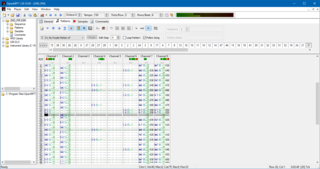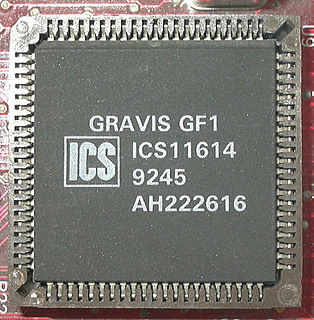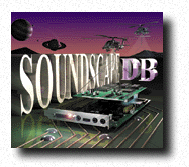
MIDI is a technical standard that describes a communications protocol, digital interface, and electrical connectors that connect a wide variety of electronic musical instruments, computers, and related audio devices for playing, editing, and recording music. The specification originates in the paper Universal Synthesizer Interface published by Dave Smith and Chet Wood of Sequential Circuits at the 1981 Audio Engineering Society conference in New York City.

A sound card is an internal expansion card that provides input and output of audio signals to and from a computer under control of computer programs. The term sound card is also applied to external audio interfaces used for professional audio applications.

A music tracker is a type of music sequencer software for creating music. The music is represented as discrete musical notes positioned in several channels at discrete chronological positions on a vertical timeline. A music tracker's user interface is usually number based. Notes, parameter changes, effects and other commands are entered with the keyboard into a grid of fixed time slots as codes consisting of letters, numbers and hexadecimal digits. Separate patterns have independent timelines; a complete song consists of a master list of repeated patterns.
Wavetable synthesis is a sound synthesis technique used to create periodic waveforms. Often used in the production of musical tones or notes.

Sound Blaster is a family of sound cards designed by Singaporean technology company Creative Technology. Sound Blaster sound cards were the de facto standard for consumer audio on the IBM PC compatible system platform, until the widespread transition to Microsoft Windows 95, which standardized the programming interface at application level, and the evolution in PC design led to onboard audio electronics, which commoditized PC audio functionality. By 1995, Sound Blaster cards had sold over 15 million units worldwide and accounted for seven out of ten sound card sales.
Digital waveguide synthesis is the synthesis of audio using a digital waveguide. Digital waveguides are efficient computational models for physical media through which acoustic waves propagate. For this reason, digital waveguides constitute a major part of most modern physical modeling synthesizers.

Yamaha XG is an extension to the General MIDI standard, created by Yamaha. It is similar in purpose to the Roland GS standard.

The Gravis UltraSound or GUS is a sound card for the IBM PC compatible system platform, made by Canada-based Advanced Gravis Computer Technology Ltd. It was very popular in the demoscene during the 1990s.

The Roland MT-32 Multi-Timbre Sound Module is a MIDI synthesizer module first released in 1987 by Roland Corporation. It was originally marketed to amateur musicians as a budget external synthesizer with an original list price of $695. However, it became more famous along with its compatible modules as an early de facto standard in computer music. Since it was made prior to the release of the General MIDI standard, it uses its own proprietary format for MIDI file playback.

There have been various families of Yamaha audio controllers labelled as YMF7xx.

The SoundscapeDB is an Ensoniq-designed and produced MIDI daughtercard designed to interface with the "Waveblaster" pin header available on many older sound cards. It was released in 1994.

The Ensoniq AudioPCI is a PCI-based sound card released in 1997. It was Ensoniq's last sound card product before they were acquired by Creative Technology. The card represented a shift in Ensoniq's market positioning. Whereas the Soundscape line had been made up primarily of low-volume high-end products full of features, the AudioPCI was designed to be a very simple, low-cost product to appeal to system OEMs and thus hopefully sell in mass quantities.
The Roland SC-55 is a GS MIDI sound module released in 1991 by Roland. The SC-55 was the first sound module to incorporate the new General MIDI standard. It was the first in the Roland Sound Canvas series.

Sound Blaster Live! is a PCI add-on sound card from Creative Technology Limited for PCs. Moving from ISA to PCI allowed the card to dispense with onboard memory, storing digital samples in the computer's main memory and then accessing them in real time over the bus. This allowed for a much wider selection of, and longer playing, samples. It also included higher quality sound output at all levels, quadrophonic output, and a new MIDI synthesizer with 64 sampled voices. The Live! was introduced in August 1998 and variations on the design remained Creative's primary sound card line into the 2000s.

The Sound Blaster 16 is a series of sound cards by Creative Technology. They are add-on boards for PCs with an ISA or PCI slot.

The Sound Blaster AWE32 is an ISA sound card from Creative Technology. It is an expansion board for PCs and is part of the Sound Blaster family of products. The Sound Blaster AWE32, introduced in March 1994, was a near full-length ISA sound card, measuring 14 inches (356 mm) in length, due to the number of features included.

Windows Sound System (WSS) is a sound card specification developed by Microsoft released at the end of 1992 for Windows 3.1. WSS featured support for up to 16-bit, 48 kHz digital sampling, beyond the capabilities of the popular contemporary Sound Blaster Pro, although it was less frequently supported than Sound Blaster and Gravis sound cards, as well as Roland sound cards, daughterboards, and sound modules. In addition, the WSS featured RCA analog audio outputs, an uncommon feature among sound cards of this era; other connections were a microphone input, a stereo line input and a stereo headphone output.

E-MU Systems was a software synthesizer, audio interface, MIDI interface, and MIDI keyboard manufacturer. Founded in 1971 as a synthesizer maker, E-mu was a pioneer in samplers, sample-based drum machines and low-cost digital sampling music workstations.

The Roland SC-7 General MIDI Sound Module is a stand-alone MIDI synthesizer module by Roland Corporation. It was released in 1992. It supports the General MIDI System and can also be used as a MIDI interface for a computer. The Roland SC-7 provides the basic (capital) Roland Sound Canvas sounds in a compact design for stand-alone, IBM PC/AT or Apple Macintosh computer use.

















